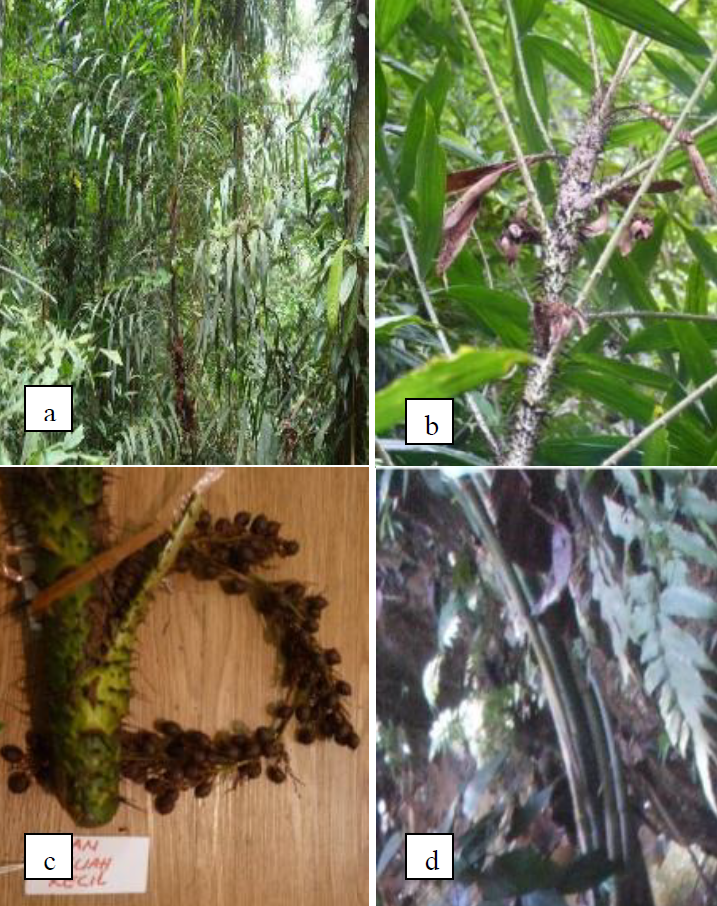Population of Potential Rattan in Bukit Tiban Protection Forest, Batam, Indonesia

Downloads
Rattan is one of the promising non-timber forest products which grow widely in Indonesia. The occurrence of rattan species, especially the commercial species, is threatened due to illegal over-exploitation. The study has been done in the Bukit Tiban Protection Forest (BTPF) to investigate the occurrence of rattan species and observe the characteristic of morphology properties and their utilization. In this study, a descriptive exploration method was applied and we performed an interview with local people in the field regarding the utilization. Morphological characteristics observed including habitus, leaves (such as color, leaflets, leaf arrangement, knee, ocrea, and climbing organ/cirrus/flagellum), and fruit. The identification key, illustrations, as well as the diagnostic character of each species were presented. Ten species of rattans were found in the BTPF, namely Calamussp.1 (Daemonorops verticillaris(Griff.) Martius), Calamussp.2 (Calamus rugosusBeccari), rotan sabut (Daemonorops sabutBeccari), rotan buah kecil (Daemonorops didymophyllaBeccari), Plectocomiasp. (Plectocomia elongate Martius ex Blume), rotan bukit (Daemonorops sepalBeccari), rotan dahan (Korthalsia rostrataBlume), Calamussp.5 (Calamus spectatissimusFurtado), Calamussp. (Daemonorops longipes(Griff.) Martius), and Calamus sp.6 (Calamus tanakadateiFurtado). Those ten species of rattan are potentially used for handicrafts, basketry, and ropes. Only five of ten species of rattan have been used commercially.
Ariana, G., Noorhidayati., & Aminudin, P. (2011). Inventarisasi dan Kerapatan Tumbuhan Palem Suku Palmaceaeyang Terdapat di Kawasan Air Terjun Hutan Lindung Gunung Gedambaan, Desa Gedambaan, Kabupaten Kotabaru. Jurnal Wahana-Bio,5,50-68.
Andayani, D., Nurtjahya, E., & Rustiami, H. (2018). KeanekaragamanPalem di Pulau Mendanau, Belitung. Berita Biologi 17(3): 225-349.
Arifin,Y. F., & Mitlohner. (2003). Traditional Rattan Gardens in Central Kalimantan, Indonesia. XII WorldForestry Congress. Quebec City, Canada.
Departemen Kehutanan. (2009). Peraturan Menteri Kehutanan Republik Indonesia Nomor P.19/Menhut-II/2009 tentang Strategi PengembanganHasil Hutan Bukan Kayu Nasional. Jakarta, Indonesia: Biro Hukum dan Organisasi Dephut.
Departemen Kehutanan. (2010). Peraturan Menteri Kehutanan Nomor P.6/Menhut -II/2010 tentang Norma, Standar, Prosedur dan KriteriaPengelolaan Hutan pada Kesatuan Pengelolaan Hutan Lindung (KPHL) dan Kesatuan Pengelolaan Hutan Produksi (KPHP). Jakarta, Indonesia:Biro Hukum dan Organisasi Dephut.
Dransfield, J., Natalie W. Uhl., & Asmussen, C. B. (2008). Genera Palmarum: the evolution and classification of palms. Richmond, UK: Royal BotanicGardens, Kew.
Hazliansyah. (2014). 265 Hektare Hutan Lindung di Batam Terbakar. Retrived February 15, 2018, fromRepublika.co.id
Jasni, Damayanti, R., & Kalima,T. (2012). Atlas Rotan Indonesia Jilid 1. Bogor, Indonesia: Pusat Penelitian danPengembangan Keteknikan Kehutanan dan Pengolahan Hasil Hutan.
Kalima,T. (2008). KeragamanSpesies Rotan Yang Belum Dimanfaatkan di Hutan Tumbang Hiran, Katingan, Kalimantan Tengah. Info Hutan 5(2):161-175.
Kalima,T. (2014). Panduan Teknis Pengumpulan Herbarium Rotan. Bogor, Indonesia: Pusat Penelitian Dan Pengembangan Konservasi Dan Rehabilitasi.
Kalima, T., & Susilo, A. (2015).The Future Prospect of Rattan as Food Resources in Central Kalimantan. Proceeding of 6th International Conference on Global Resource Conservation. p.62-68.
Kalima,T., & Jasni. (2015). Prioritas penelitian dan pengembangan jenis andalan setempatrotan.Manajemen Perlindungan, Penelitian dan Pemanfaatan Keanekaragaman Hayati di Wilayah Perkotaan.Prosiding Seminar Nasional Masyarakat Biodiversitas Indonesia 1(8):2407–8050.
Kalima,T., & Rustiami, H. (2018). Identifikasi dan Pertelaan Jenis Rotan pulau Jawa. Bogor, Indonesia: CV SinarJaya
Kalima, T., Damayanti, R., & Susilo, A. (2019). Rotan Potensialdari Hutan Bukit Lubuk Pekak, Merangin, Jambi. Journal of Tropical Biodiversity and Biotechnology 4(1): 32-41.
Krisdianto, Jasni., & Tutiana.(2018).AnatomicalProperties of Nine Indigenous Rattan Species of Jambi, Indonesia. Indonesian Journal of Forestry Research 5(2):147-161.
Kusnaedi, I., & Pramudita, A.S. (2013). Sistem BendingPada Proses Pengolahan Kursi Rotan di Cirebon. Jurnal Rekajiva 1(2): 1-13.
Matangaran, J.R., & Puspitasari, L. (2012). Potensi dan Pemanenan Buah Rotan Jernang.Jurnal Silvikultur Tropika3(1): 65-70.
Pari, R., Abdurachman, Jasni, & Kalima,T. (2018). Klasifikasi Mutu 11 Jenis Rotan Indonesia Berdasarkan Kerapatan Dan Keteguhan Lentur. Jurnal Penelitian Hasil Hutan 36(1):13-22.
Rachmat, H.H., Fambayun, R.A., Yulita, K.S., & Susilowati, A. (2020). Ex-situ conservation and management of dipterocarps genetic resources through seedlings collections and nursery establishment. Journal of Biological Diversity21(2):556-563.
Rezkisari,I. (2014). Kebakaran Hutan Batam Meluas. Retrived FebruaryFebruary 15, 2018, from republika.co.id.
Rifardi. (2008). Ecological degradationof land and forest resources in Semenanjung Kampar peatland forest, Riau Province. Bumi Lestari Journal of Environment8(2):145–153.
Roy, B., Fahrizal., & Diba,F. (2017).Studi Pemanfaatan Rotan Oleh Masyarakat Di Desa Sekilap Kecamatan Mandor Kabupaten Landak.Jurnal Hutan Lestari 5(3): 583-591.
Setiyohadi, I. (2016). Karakteristik dan Pola Pergerakan Penduduk Kota Batam dan Hubungannyadengan Perkembangan Wilayah Hinterland. Jurnal Dimensi1(1):1-18. Universitas Riau Kepulauan.
Suharti, S. (2015). Peningkatan pendapatan masyarakat meleluibudidaya komoditas Aneka Usaha Kehutanan (AUK). Seminar Nasional Masyarakat Biodiversitas 2(3): 1416-1419.
Yuliastrin, A. (2014).Analisis Kadar Hara Makro Tanah Yang Ditumbuhi Populasi Bintangur (Calophyllum spp.). Studi Kasus di Hutan Lindung Sei Tembesi dan Bukit Tiban, Batam. [Final Report]. UT Batam UniversitasTerbuka.
Witono, JR., Rustiami, H., Hadiah, JT., & Purnomo. (2013). Panduan Lapangan Pengenalan jenis Rotan Katingan. Indonesia: WWF-Indonesia Program Kalimantan Tengah.




